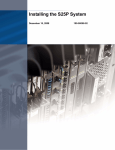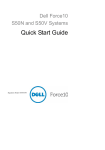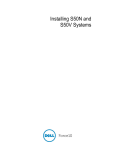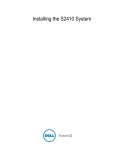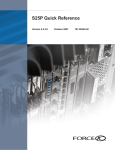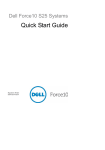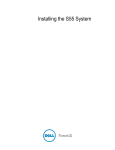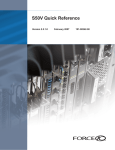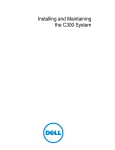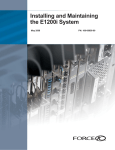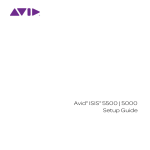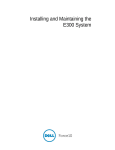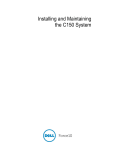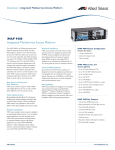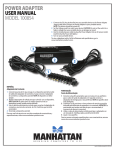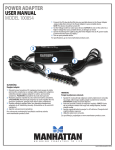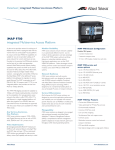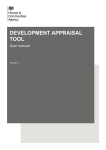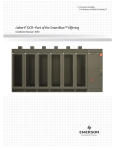Download Dell Force10 S25-01-GE-24P Installation Manual
Transcript
Installing S25N and S25V Systems
December 15, 2008
100-00061-02
Copyright 2008 Force10 Networks®
All rights reserved. Printed in the USA. December 2008.
Force10 Networks® reserves the right to change, modify, revise this publication without notice.
Trademarks
Force10 Networks® and E-Series® are registered trademarks of Force10 Networks, Inc. Force10, the Force10 logo, E1200, E600, E600i,
E300, EtherScale, TeraScale, and FTOS are trademarks of Force10 Networks, Inc. All other brand and product names are registered
trademarks or trademarks of their respective holders.
Statement of Conditions
In the interest of improving internal design, operational function, and/or reliability, Force10 Networks reserves the right to make changes to
products described in this document without notice. Force10 Networks does not assume any liability that may occur due to the use or
application of the product(s) described herein.
Note: The country-specific warnings and statements of compliance have been moved to “Agency
Compliance” on page 42, in Chapter 6, “System Specifications,” on page 41.
Contents
Preface
About this Guide . . . . . . . . . . . . . . . . . . . . . . . . . . . . . . . . . . . . . . . . . . . . . . . . . . . . . . . . . . . . 5
Information Symbols and Warnings . . . . . . . . . . . . . . . . . . . . . . . . . . . . . . . . . . . . . . . . . . . . . . . . . . . 5
Related Publications . . . . . . . . . . . . . . . . . . . . . . . . . . . . . . . . . . . . . . . . . . . . . . . . . . . . . . . . . . . . . . 7
Chapter 1
System Overview . . . . . . . . . . . . . . . . . . . . . . . . . . . . . . . . . . . . . . . . . . . . . . . . . . . . . . . . . . . . 9
Equipment . . . . . . . . . . . . . . . . . . . . . . . . . . . . . . . . . . . . . . . . . . . . . . . . . . . . . . . . . . . . . . . . . . . . . 10
Features . . . . . . . . . . . . . . . . . . . . . . . . . . . . . . . . . . . . . . . . . . . . . . . . . . . . . . . . . . . . . . . . . . . . . . .11
Ports . . . . . . . . . . . . . . . . . . . . . . . . . . . . . . . . . . . . . . . . . . . . . . . . . . . . . . . . . . . . . . . . . . . . . . . . . .11
System Status . . . . . . . . . . . . . . . . . . . . . . . . . . . . . . . . . . . . . . . . . . . . . . . . . . . . . . . . . . . . . . . . . . 12
LED Displays . . . . . . . . . . . . . . . . . . . . . . . . . . . . . . . . . . . . . . . . . . . . . . . . . . . . . . . . . . . . . . . 12
Chapter 2
Site Preparation . . . . . . . . . . . . . . . . . . . . . . . . . . . . . . . . . . . . . . . . . . . . . . . . . . . . . . . . . . . . 15
Site Selection . . . . . . . . . . . . . . . . . . . . . . . . . . . . . . . . . . . . . . . . . . . . . . . . . . . . . . . . . . . . . . . . . . . 15
Cabinet Placement . . . . . . . . . . . . . . . . . . . . . . . . . . . . . . . . . . . . . . . . . . . . . . . . . . . . . . . . . . . . . . 16
Rack Mounting . . . . . . . . . . . . . . . . . . . . . . . . . . . . . . . . . . . . . . . . . . . . . . . . . . . . . . . . . . . . . . . . . . 16
Fans and Airflow . . . . . . . . . . . . . . . . . . . . . . . . . . . . . . . . . . . . . . . . . . . . . . . . . . . . . . . . . . . . . . . . 16
Power . . . . . . . . . . . . . . . . . . . . . . . . . . . . . . . . . . . . . . . . . . . . . . . . . . . . . . . . . . . . . . . . . . . . . . . . 17
S25N . . . . . . . . . . . . . . . . . . . . . . . . . . . . . . . . . . . . . . . . . . . . . . . . . . . . . . . . . . . . . . . . . . . . . . 17
S25V . . . . . . . . . . . . . . . . . . . . . . . . . . . . . . . . . . . . . . . . . . . . . . . . . . . . . . . . . . . . . . . . . . . . . . 17
Power over Ethernet (PoE) Support . . . . . . . . . . . . . . . . . . . . . . . . . . . . . . . . . . . . . . . . . . . . . . 17
Storing Components . . . . . . . . . . . . . . . . . . . . . . . . . . . . . . . . . . . . . . . . . . . . . . . . . . . . . . . . . . . . . 18
Tools Required . . . . . . . . . . . . . . . . . . . . . . . . . . . . . . . . . . . . . . . . . . . . . . . . . . . . . . . . . . . . . . . . . 18
Chapter 3
Installing the Switch . . . . . . . . . . . . . . . . . . . . . . . . . . . . . . . . . . . . . . . . . . . . . . . . . . . . . . . . 19
Inserting Optional Modules (10-Gigabit or Stacking) . . . . . . . . . . . . . . . . . . . . . . . . . . . . . . . . . . . . . 19
Installing the System on a Tabletop . . . . . . . . . . . . . . . . . . . . . . . . . . . . . . . . . . . . . . . . . . . . . . . . . . 21
Installing the System in a Rack or Cabinet . . . . . . . . . . . . . . . . . . . . . . . . . . . . . . . . . . . . . . . . . . . . 21
Two-Post Rack Mounting . . . . . . . . . . . . . . . . . . . . . . . . . . . . . . . . . . . . . . . . . . . . . . . . . . . . . . 21
Four-Post Rack-mounting with Threaded Rails . . . . . . . . . . . . . . . . . . . . . . . . . . . . . . . . . . . . . 22
Installing S25Nand S25V Systems
3
Four-Post Rack-mounting with Cage Nuts . . . . . . . . . . . . . . . . . . . . . . . . . . . . . . . . . . . . . . . . . 23
Stacking . . . . . . . . . . . . . . . . . . . . . . . . . . . . . . . . . . . . . . . . . . . . . . . . . . . . . . . . . . . . . . . . . . . . . . . 26
Using FTOS Stacking Commands . . . . . . . . . . . . . . . . . . . . . . . . . . . . . . . . . . . . . . . . . . . . . . . 26
Connecting Stack Ports (optional) . . . . . . . . . . . . . . . . . . . . . . . . . . . . . . . . . . . . . . . . . . . . . . . . 27
Supplying Power . . . . . . . . . . . . . . . . . . . . . . . . . . . . . . . . . . . . . . . . . . . . . . . . . . . . . . . . . . . . . . . . 29
S25V . . . . . . . . . . . . . . . . . . . . . . . . . . . . . . . . . . . . . . . . . . . . . . . . . . . . . . . . . . . . . . . . . . . . . . 29
Chapter 4
Installing Backup Power . . . . . . . . . . . . . . . . . . . . . . . . . . . . . . . . . . . . . . . . . . . . . . . . . . . . . 31
Backup Power Components . . . . . . . . . . . . . . . . . . . . . . . . . . . . . . . . . . . . . . . . . . . . . . . . . . . . . . . 31
The Power Connections on the Switch . . . . . . . . . . . . . . . . . . . . . . . . . . . . . . . . . . . . . . . . . . . . . . . 32
Installing the Redundant DC Power Supply for the S25V . . . . . . . . . . . . . . . . . . . . . . . . . . . . . . . . . 33
Inserting Tandem PSUs into a Rack . . . . . . . . . . . . . . . . . . . . . . . . . . . . . . . . . . . . . . . . . . . . . . 34
Connecting the DC-to-DC Cable . . . . . . . . . . . . . . . . . . . . . . . . . . . . . . . . . . . . . . . . . . . . . . . . . 34
Chapter 5
Installing Ports . . . . . . . . . . . . . . . . . . . . . . . . . . . . . . . . . . . . . . . . . . . . . . . . . . . . . . . . . . . . . 37
Accessing the Console Port . . . . . . . . . . . . . . . . . . . . . . . . . . . . . . . . . . . . . . . . . . . . . . . . . . . . . . . 37
Connecting S25V Ethernet Ports with PoE . . . . . . . . . . . . . . . . . . . . . . . . . . . . . . . . . . . . . . . . . . . . 38
Installing Optics . . . . . . . . . . . . . . . . . . . . . . . . . . . . . . . . . . . . . . . . . . . . . . . . . . . . . . . . . . . . . . . . . 39
Installing SFPs . . . . . . . . . . . . . . . . . . . . . . . . . . . . . . . . . . . . . . . . . . . . . . . . . . . . . . . . . . . . . . 39
Installing XFPs . . . . . . . . . . . . . . . . . . . . . . . . . . . . . . . . . . . . . . . . . . . . . . . . . . . . . . . . . . . . . . 40
Chapter 6
System Specifications . . . . . . . . . . . . . . . . . . . . . . . . . . . . . . . . . . . . . . . . . . . . . . . . . . . . . . . 41
Physical Design . . . . . . . . . . . . . . . . . . . . . . . . . . . . . . . . . . . . . . . . . . . . . . . . . . . . . . . . . . . . . . . . 41
Environmental Parameters . . . . . . . . . . . . . . . . . . . . . . . . . . . . . . . . . . . . . . . . . . . . . . . . . . . . . . . . 41
Power Requirements . . . . . . . . . . . . . . . . . . . . . . . . . . . . . . . . . . . . . . . . . . . . . . . . . . . . . . . . . . . . . 42
Agency Compliance . . . . . . . . . . . . . . . . . . . . . . . . . . . . . . . . . . . . . . . . . . . . . . . . . . . . . . . . . . . . . . 42
Safety Standards and Compliance Agency Certifications . . . . . . . . . . . . . . . . . . . . . . . . . . . . . . 44
Electromagnetic Compatibility (EMC) . . . . . . . . . . . . . . . . . . . . . . . . . . . . . . . . . . . . . . . . . . . . . 44
Product Recycling and Disposal . . . . . . . . . . . . . . . . . . . . . . . . . . . . . . . . . . . . . . . . . . . . . . . . . 45
Appendix A
Technical Support . . . . . . . . . . . . . . . . . . . . . . . . . . . . . . . . . . . . . . . . . . . . . . . . . . . . . . . . . . 47
The iSupport Website . . . . . . . . . . . . . . . . . . . . . . . . . . . . . . . . . . . . . . . . . . . . . . . . . . . . . . . . . . . . 47
Accessing iSupport Services . . . . . . . . . . . . . . . . . . . . . . . . . . . . . . . . . . . . . . . . . . . . . . . . . . . . 48
Contacting the Technical Assistance Center . . . . . . . . . . . . . . . . . . . . . . . . . . . . . . . . . . . . . . . . . . . 49
Locating Serial Numbers . . . . . . . . . . . . . . . . . . . . . . . . . . . . . . . . . . . . . . . . . . . . . . . . . . . . . . . . . . 49
Requesting a Hardware Replacement . . . . . . . . . . . . . . . . . . . . . . . . . . . . . . . . . . . . . . . . . . . . . . . 50
Index . . . . . . . . . . . . . . . . . . . . . . . . . . . . . . . . . . . . . . . . . . . . . . . . . . . . . . . . . . . . . . . . . . . . . 51
4
Preface
About this Guide
This guide provides site preparation recommendations, step-by-step procedures for rack mounting and
desk mounting, inserting optional modules, and connecting to a power source.
After you have completed the hardware installation and power-up of the system, refer to the FTOS
Configuration Guide for the S-Series for software configuration information and the FTOS Command
Reference for the S-Series for detailed Command Line Interface (CLI) information, as detailed in Related
Publications, below.
Information Symbols and Warnings
The following graphic symbols are used in this document to bring attention to hazards that exist when
handling the system and its components. Please read these alerts and heed their warnings and cautions.
Table 1 describes symbols contained in this guide.
Table 1 Information Symbols
Symbol
Warning
Description
Danger
This symbol warns that improper handling and installation could result in bodily injury.
Before you begin work on this equipment, be aware of hazards involving electrical
circuitry, networking environments, and instigate accident prevention procedures.
Caution
This symbol informs you that improper handling and installation could result in equipment
damage or loss of data.
Warning
This symbol informs you that improper handling may reduce your component or system
performance.
Note
This symbol informs you of important operational information.
Danger: The installation of this equipment shall be performed by trained and qualified personnel only.
Read this guide before installing and powering up this equipment. This equipment contains two power
cords. Disconnect both power cords before servicing.
Installing S25N and S25V Systems
5
Danger: Class 1 laser product.
Attention: Produit laser de classe 1
Warnung: Laserprodukt der Klasse 1
This equipment contains optical transceivers, which comply with the limits of Class 1 laser radiation.
Visible and invisible laser radiation may be emitted from the aperture of the optical transceiver ports when
no cable is connected. Avoid exposure to laser radiation and do not stare into open apertures.
Warning: Building Supply Notice for AC Power Supply Use
This product relies on the building's installation for short-circuit (overcurrent) protection. Ensure that a
fuse or circuit breaker no larger than 120 VAC, 15A U.S. (240 VAC, 10A international) is used on the
phase conductors (all current-carrying conductors).
Attention: Pour ce qui est de la protection contre les courts-circuits (surtension), ce produit dépend de
l'installation électrique du local. Vérifier qu'un fusible ou qu'un disjoncteur de 120 V alt., 15 A U.S.
maximum (240 V alt., 10 A international) est utilisé sur les conducteurs de phase (conducteurs de charge).
Warnung: Dieses Produkt ist darauf angewiesen, daß im Gebäude ein Kurzschluß- bzw.
Überstromschutz installiert ist. Stellen Sie sicher, daß eine Sicherung oder ein Unterbrecher von nicht
mehr als 240 V Wechselstrom, 10 A (bzw. in den USA 120 V Wechselstrom, 15 A) an den Phasenleitern
(allen stromführenden Leitern) verwendet wird.
Warning: Building Supply Notice for DC Power Supply Use
An external disconnect must be provided and be easily accessible. Force10 Networks recommends the use
of a 60A circuit breaker.
ATTENTION: Un interrupteur externe doit être fournis et doit être facilement accessible. Force10
Networks recommande l'utilisation d'un disjoncteur de 60Ampères.
WARNUNG: Eine leicht zugängliche Tren Force10 Networks nvorrichtung muss in der Verdrahtung
eingebaut sein. Force10 Networks empfiehlt einen 60A Sicherungsautomaten zu benutzen.
Caution: Wear grounding wrist straps when handling this equipment to avoid ESD damage.
Caution: Earthing (AKA grounding) connection essential before connecting supply. Always make the
ground connection first and disconnect it last.
Caution: Disposal of this equipment should be handled according to all national laws and regulations. See
Product Recycling and Disposal on page 45.
6
About this Guide
Caution: This unit has more than one power supply connection; all connections must be removed to
remove all power from the unit.
ATTENTION: Cette unité est équipée de plusieurs raccordements d'alimentation. Pour supprimer tout courant
électrique de l'unité, tous les cordons d'alimentation doivent être débranchés.
WARNUNG: Diese Einheit verfügt über mehr als einen Stromanschluß; um Strom gänzlich von der Einheit
fernzuhalten, müssen alle Stromzufuhren abgetrennt sein.
Caution: Lithium Battery Notice
Danger of explosion if battery is replaced with incorrect type. Replace only with the same type recommended by the
manufacturer. Dispose of used batteries according to the manufacturer's instructions.
ACHTUNG - Explosionsgefahr wenn die Battery in umgekehrter Polarität eingesetzt wird. Nur miteinem gleichen
oder ähnlichen, vom Hersteller empfohlenen Typ, ersetzen. Verbrauchte Batterien müssen per den Instructionen des
Herstellers verwertet werden.
ATTENTION - Il y a danger d'explosion s'il a remplacement incorrect de la batterie. Remplacer uniquement avec
une batterie du meme type ou d'un type equivalent recommande par le constructeur. Mettre au rebut les batteries
usagees conformement aux instructions du fabricant.
Note: Other cautionary statements appear in context elsewhere in this book.
Related Publications
The S25N and S25V run FTOS version 7.7.1.0 or greater. Refer to the following documents:
•
•
•
FTOS Configuration Guide for the S-Series
FTOS Command Reference for the S-Series
S-Series and FTOS Release Notes
The FTOS Documentation CD-ROM contains the S-Series hardware guides and the FTOS files listed
above. The CD-ROM also has:
•
•
•
•
MIBs: Files for all SNMP MIBs supported by the software
Data sheets: Links to Force10 product data sheets
Security: Description and supporting files for setting up SSH, SSL, and HTTPS access to the switch
Training: PDF files of the slide shows used in training
Note: Documentation CD-ROMs do not have software or Release Notes. For the most recent
documentation and software, please visit iSupport (registration for access to some sections is required):
https://www.force10networks.com/CSPortal20/Main/SupportMain.aspx
The iSupport website also has a section for S-Series techtips and FAQs. For more information in this book
on technical support, see Technical Support on page 39.
Installing S25N and S25V Systems
7
8
About this Guide
Chapter 1
System Overview
The S25N (Cat# S25-01-GE-24T) and S25V (Cat# S25-01-GE-24V) models of the S-Series are high
performance, low cost, stackable, Layer 2 switch/Layer 3 routers that support 24 built-in 10/100/1000
Base-T ports with four shared 1GbE SFP (small form-factor pluggable) ports, and two rear expansion slots
that can host stacking ports or up to four 10GbE ports. The two differences between the two models are:
• The S25V supports Power over Ethernet (PoE) through its 24 copper ports (see Connecting S25V
Ethernet Ports with PoE on page 38), while the S25N does not.
• The S25V has both AC (470W) and DC power inputs, while the S25N has two AC inputs (150W+150W).
See Supplying Power on page 29. The S25V can also use the Force10 470W Redundant DC Power
Supply (see Chapter 4, Installing Backup Power, on page 31) in current sharing (additive) mode.
Figure 1 shows the front panel of the S25V. The S25N has almost the same layout, except that the catalog
name differs, and an AC2 status LED replaces the DC status LED.
Figure 1 The S25V Front View
Status Panel
LEDs
Stack ID
Indicator
LED
OK
Alarm
AC
DC
XFP25
XFP27
XFP26
XFP28
Link/Active
Indicator LEDs
(SFP Ports 21-24)
Catalog Name (S25-01-GE-24V)
Alarm
AC
STACK ID
S25-01-GE-24V
DC
XFP25
27
XFP26
P28
Installing S25N and S25V Systems
Ethernet Ports (10/100/1000)
SFP
Ports (21-24)
fn00157s25NV
RJ-45 Console Port
Shared
10/100/1000
Ports (21-24)
9
Figure 2 The S25V Rear View
Label (Part #, Serial #, MAC Address, Bar Code, FRU #)
DC Power
10-Gigabit Modules or Stacking Modules (optional)
11.5
-48V
Current
FG RTN -48V Sharing
27
fn00158s25V
28
25
26
Ethernet Port Numbers
25 to 28, Right to Left
Ground Connector
AC Power Receptacle
Figure 3 The S25N Rear View
Label (Part #, Serial #, MAC Address, Bar Code, FRU #)
10-Gigabit Modules or Stacking Modules (optional)
fn00158s25P
28
27
26
25
Ethernet Port Numbers 25 to 28
(numbered right to left, facing rear)
Ground Connector
Dual AC Power Receptacles
Equipment
The following items are necessary to install the system:
•
•
•
•
•
The switch
At least one grounded AC power source for the S25N switch (ideally two for the two AC receptacles),
and one for the S25V. The S25V provides the option of using DC power with, or in addition to, AC.
Cable (included) to connect the AC power source to the switch
Brackets (“rack ears”) for rack installation (included)
Screws for rack installation (included) and #2 Phillips screwdriver (not supplied)
Other optional components are:
•
•
•
•
•
10
Stacking cables for connecting switches when stacked (not supplied). See Connecting Stack Ports
(optional) on page 27.
Backup DC Power Module (see Chapter 4, Installing Backup Power, on page 31)
Rear rack-mounting kits (see Installing the System in a Rack or Cabinet on page 21)
Optical networking components (see Chapter 5, Installing Ports, on page 37)
Stacking components (see Ports, below)
System Overview
Features
•
•
•
•
•
•
•
•
•
•
Dual power supplies:
— S25N: Two 150W AC power supplies (two receptacles; see Figure 3 on page 10) acting in
load-sharing mode.
— S25V: Internal AC (110v/220v auto-detect) and DC (-48V) power supplies (see Figure 2 on
page 10) each capable of 470W, and acting in load-sharing mode. The S25V has built-in support
for 360W Power over Ethernet (PoE) — IEEE 802.3af — through the copper ports, with power
allocation controll available through the CLI. The optional Force10 470W DC Redundant Power
Supply can be attached in current-sharing mode to provide up to 940W (790W of PoE).
Supports up to 16384 MAC address entries supported with hardware-assisted aging
Stackable switch features
19-inch rack-mountable and standard 1U chassis height
Fans:
— S25N: Four fans with automatic speed adjustment for temperature changes
— S25V: Five fans with automatic speed adjustment for temperature changes
Supports 9252-byte jumbo frames
Back-pressure support at half-duplex, IEEE 802.3x flow control at full duplex
Extensive LED system with per-port LEDs
32MB internal Flash memory
256MB RAM
Ports
•
•
•
•
24 fixed 10/100/1000 Mbps auto-sensing and auto-MDIX RJ45 ports (The S25V provides up to 15.4W
PoE to each port.)
Four SFP ports that share port numbers 21–24 with the copper ports and capable of using 10/100/1000
Base-T or 1000 Base-X using auto-media detect
Console port (see Chapter 5, Installing Ports, on page 37): Supplied with console cable
(straight-through Ethernet copper cable) and terminal adapter (DB-9 to RJ-45)
Expansion slots that accept any combination of the following optional, high-capacity uplink modules:
10GbE XFP (two ports), 10GbE CX4 (two ports), 12G stacking (two ports) or 24G stacking (one port).
See Inserting Optional Modules (10-Gigabit or Stacking) on page 19 and Connecting Stack Ports
(optional) on page 27.
Installing S25N and S25V Systems
11
System Status
Chassis status can be derived in several ways, including physical LED displays and boot menu options,
along with CLI show commands and SNMP traps. For details on boot menu and CLI options, see:
•
•
The CLI Basics and BOOT_USER chapters in the FTOS Command Reference for the S-Series
The Configuration Fundamentals and Getting Started chapters in the FTOS Configuration Guide for
the S-Series
LED Displays
As shown in Figure 1 on page 9, the front panel of the switch contains several sets of LEDs:
•
The LED group labeled “STACK ID” at the far left of the front panel displays the stack ID of the unit.
See Stack ID in Table 3. For more on unit numbering, see Stacking on page 26.
• Each port has status indicator LEDs, described in Table 2.
• A group of status indicator LEDs are on the left side of the front panel, described in Table 3.
Table 2 Port LED Displays
Feature
Description
10/100/1000 Port LED*
Speed LED (left side of each port)
Green — 1000M
Amber — 100M
Off — 10M
Link/Active LED (right side of each port)
Green — Link up on this port
Blinking Green — Activity, transmitting or receiving packet at this port.
Amber — Link up and power supplied on this port
Blinking Amber – Transmitting or receiving packets on the port and sending PoE
power to PD (power device)
Off — No Link detected at this port
SFP Port LED*
Link LED
Green — Link up on this port
Off — No link detected on this port
Activity LED
Blinking Green — Activity, transmitting or receiving packet in link up state
Off — No activity on this port
XFP Port LED
Link/Activity LED (Each XFP port has a status LED on the module and in the LED group
at the left front of the switch)
Green — Link up on this port
Blinking Green — Activity, transmitting or receiving packet in link up state
Off — No link detected on this port
* The SFP ports have priority over the four shared 10/100/1000 ports (ports 21–24). LEDs for a 10/100/1000 port are inactive if the
shared SFP port (also labeled 21 through 24) is enabled.
12
System Overview
Table 3 describes the LED status indicators on the left side of the front panel.
Table 3 Status Panel LED Display
Label
LED Color
Description
Left Side of the Status LED Group
OK
AC1 (on S25N)
AC (on S25V)
XFP25*
XFP26*
STACK ID
Green
Unit is online.
Off
Unit is powered off.
Green Blinking
Unit is booting up. (blinking rate is 16 Hz)
Amber
Error during boot-up.
Green
Power supply is present and OK.
Amber
Power supply is present but failed.
Off
Power supply is not present.
Green
A valid 10G link is established on the port.
Blinking Green
Transmitting or receiving packets on the port.
Off
No link is established on the port.
Green
A valid 10G link is established on the port.
Blinking Green
Transmitting or receiving packets on the port.
Off
No link is established on the port.
Green
Indicates the stack ID (sometimes called "switch ID") of the unit.
Starting with FTOS 7.8.1.0:
•
•
•
“A” is displayed to the left of the stack ID if the unit is a standalone or
master (management) unit.
“B” is displayed for a standby unit. (Actually, it’s an 8, because of the
limitations of the 7-segment LED.)
“0” is displayed next to the stack ID, as before, for the other units.
Right Side of the Status LED Group
Alarm
AC2 (on S25N)
DC (on S25V)
XFP27*
XFP28*
Amber
Minor alarm: Fan or temperature is operating outside parameters.
Red
Major alarm
Off
No alarm
Green
Power supply is present and OK.
Amber
Power supply is present but failed.
Off
Power supply is not present.
Green
A valid 10G link is established on the port.
Blinking Green
Transmitting or receiving packets on the port.
Off
No link is established on the port.
Green
A valid 10G link is established on the port.
Blinking Green
Transmitting or receiving packets on the port.
Off
No link is established on the port.
* Each of the four XFP LEDs on the front panel also indicate the status when CX4 ports are installed in the rear bays.
Installing S25N and S25V Systems
13
14
System Overview
Chapter 2
Site Preparation
This chapter describes requirements and procedures to install your S25N or S25V system, in the following
topics:
•
•
•
•
•
•
•
Site Selection
Cabinet Placement on page 16
Rack Mounting on page 16
Fans and Airflow on page 16
Power on page 17
Storing Components on page 18
Tools Required on page 18
For detailed system specifications, refer to Chapter 6, System Specifications, on page 41.
Note: Install the system into a rack or cabinet before installing any optional components.
Site Selection
Make sure that the area where you install the system meets the following safety requirements:
•
•
•
•
•
•
Near an adequate power source. Connect the system to the appropriate branch circuit protection as
defined by your local electrical codes.
Ambient temperature between 32° – 122°F (0° – 50°C).
Relative humidity that does not exceed 85% non-condensing.
In a dry, clean, well-ventilated, and temperature-controlled room, away from heat sources such as hot
air vents or direct sunlight.
Away from sources of severe electromagnetic noise.
Positioned in a rack, cabinet, or on a desktop with adequate space in the front, rear, and sides of the
unit for proper ventilation, and access.
Installing S25N and S25V Systems
15
Cabinet Placement
The cabinet must meet the following criteria:
•
•
Minimum cabinet size and airflow are according to the EIA standard.
Minimum of 5 inches (12.7 cm) between the side intake and exhaust vents and the cabinet wall.
Rack Mounting
When you prepare your equipment rack, ensure that the rack is earth ground. The equipment rack must be
grounded to the same ground point used by the power service in your area. The ground path must be
permanent.
Fans and Airflow
Ventilation is side-to-side, with five fans (four fans in the S25N) on the left side of the switch that operate
at a constant speed. For proper ventilation, position the system in an equipment rack (or cabinet) with a
minimum of five inches (12.7 cm) of clearance around the side intake and exhaust vents. When two
S-Series systems are installed side by side, position the two systems at least 5 inches (12.7 cm) apart to
permit proper airflow. The acceptable ambient temperature ranges are listed in Environmental Parameters
on page 41.
As listed in Table 3, “Status Panel LED Display,” on page 13, the front panel of the system has an Alarm
status LED, which is green when the switch is operating within required temperature parameters and all
components are operating normally, including fans. The LED is amber when the temperature or
components are outside expected parameters, red in a major alarm.
FTOS turns on major and minor alarms and logs temperature warnings at the following temperatures (in
degrees Celsius), and logs another message when the temperature returns to normal. The Command Line
Interface (CLI) also reports an alarm. The fan speed changes accordingly.
Table 4 Major and Minor Temperature (Degrees Celsius) Warnings
S25N
S25V
Major On
62
60
Major Off
58
56
Minor On
60
58
Minor Off
50
47
Use the show logging command to see the log messages. For details, see the logging chapters of the
Command Reference and Configuration Guide. In a stack, each unit has its own temperature monitoring
and control. Status logging is identified by unit in the system log.
Fan replacement in the field is not offered as an option.
16
Site Preparation
Power
S25N
The S25N comes standard with two 150W AC power supplies with auto-sensing 110/220V AC
receptacles, each of which, when connected to a power source, is capable of supplying all required power
to the switch. When both are connected to power sources, they act in load-sharing mode; see Figure 3 on
page 10. Use the power cords shipped with the S25N to connect it to AC power outlets, ideally on separate
circuits. Several versions of the power cord are available, based on country requirements.
Caution: The power supply cord is used as the main disconnect device; ensure that the socket-outlet is
located/installed near the equipment and is easily accessible.
S25V
As shown in Figure 2 on page 10, the right side (as you face the back of the unit) of the S25V contains one
auto-sensing 110/220V AC receptacle and a -48V DC terminal block.
When both the AC and DC power supplies are connected on the S25V, it uses them in load-sharing mode.
If the 470W DC Backup Power Supply provided by Force10 is connected to the Current Sharing
connection on the back of the S25V, the system uses the DC and AC in current-sharing mode, which is
load-sharing up to 470W, while also allowing them to provide a total of 940W. The 470W PSU is oversized
in order to support PoE, as described next. See also Backup Power Components on page 31.
For details on connecting to a power source, see Supplying Power on page 29.
Power over Ethernet (PoE) Support
Along with the optional DC power supply noted above, the S25V includes an internal 470W power supply
that supports both the operation of the switch and an independent power distribution system to supply power
to the 24 copper Ethernet ports that support the IEEE 802.3af standard for Power over Ethernet (PoE).
Connect only powered devices that adhere to IEEE 802.3af.
The total PoE power budget for the switch is between 320W and 790W, depending on the power sources
available. If the external 470W DC Force10 Redundant Power Supply (catalog # S50-01-PSU-V) is
attached to the Current Sharing terminal (see Chapter 4, Installing Backup Power, on page 31), you can use
the power-budget command in FTOS to convert its use to current-sharing mode to provide up to 790W
of PoE.
Each port can provide a maximum of 15.4W, subject to the power budget, voltage, power priority, and
power limit settings. PoE is, by default, enabled globally on a first-come, first-serve basis, until it exceeds
the total available power. Alternatively, the switch administrator can use the CLI to allocate power on a
per-port and a per-stack-unit basis, with per-port power limits and port prioritization. For a brief
introduction in this guide to the PoE commands, see Connecting S25V Ethernet Ports with PoE on
page 38.
Installing S25N and S25V Systems
17
Storing Components
If you do not install your system and components immediately, Force10 Networks recommends that you
properly store the system and all optional components until you are ready to install them. Follow these
storage guidelines:
•
•
•
•
Storage temperature should remain constant, in the range from -40° to 158° F (-40°C to 70° C).
Storage humidity should be within 10 to 90% (relative humidity), non-condensing
Store on a dry surface or floor, away from direct sunlight, heat, and air conditioning ducts.
Store in a dust-free environment.
Tools Required
S-Series switches are shipped fully assembled, encased in foam. A utility knife is useful for cutting the
packing tape, and a Philips #2 screwdriver is required for attaching rack screws, and is also used for making
some attachments, including DC cables and rear cover plates.
Warning: Electrostatic discharge (ESD) damage can occur when components are mishandled. Always
wear an ESD-preventive wrist or heel ground strap when handling the system and its accessories. After
you remove the original packaging, place the system and its components on an antistatic surface.
18
Site Preparation
Chapter 3
Installing the Switch
To install S25N or S25V systems, Force10 Networks recommends that you complete the installation
procedures in the order presented in this chapter:
•
•
•
•
•
Inserting Optional Modules (10-Gigabit or Stacking)
Installing the System on a Tabletop on page 21
Installing the System in a Rack or Cabinet on page 21
Stacking on page 26
— Using FTOS Stacking Commands on page 26
— Connecting Stack Ports (optional) on page 27
Supplying Power on page 29
Warning: As with all electrical devices of this type, take all the necessary safety precautions to prevent
injury when installing this system. Electrostatic discharge (ESD) damage can occur if components are
mishandled. Always wear an ESD-preventive wrist or heel ground strap when handling the switch and its
components.
Inserting Optional Modules (10-Gigabit or Stacking)
The S25N (catalog name S25-01-GE-24T) and S25V (catalog name S25-01-GE-24V) have two expansion
slots in the rear of the units, for which there are four modules available:
Module Description
Catalog Name
2-port 10GbE XFP (optical connection)
S50-01-10GE-2P
2-port 10GbE CX4 (copper connection)
S50-01-10GE-2C
2-port 12GbE Stacking
S50-01-12G-2S
1-port 24GbE Stacking
S50-01-24G-1S
The system supports the modules inserted in any combination of slots (although connecting all four ports
of two 12G stacking modules is not supported, nor is connecting a 12G stack port in one switch to a 24G
stack port in another switch). The ports are numbered 25 through 28, from left to right as you face the front
of the unit. So, for clarity in the use of the CLI in port assignment, if you are only using one XFP or CX4
module, insert it in the left-most expansion slot.
Note: The 10G modules cannot be used for stacking. See Connecting Stack Ports (optional) on page 27.
Installing S25N and S25V Systems
19
To install a module, follow the steps below:
Step
1
Task
If the system is on, save the running configuration, if desired (and different from the startup configuration) with
the command write memory. Then power down the system by unplugging it from its power source.
Caution: Hotswapping (inserting or removing) a module can crash and lock up the system, requiring
a power cycle.
Use a #2 Phillips screwdriver to remove either a module faceplate or an existing module. Note that these slots,
when used for 10G Ethernet ports, are assigned port numbers from left to right as you face the front of the
system. So, for clarity in programming those ports, you might favor the left-most slot for the first 10G module
that you install.
3
Grasping the module faceplate, remove the module from its packaging and slide it into the slot until the module
faceplate is flush with the rear cover of the system.
4
Secure the captive screws on either side of the module.
5
XFP: Using the optical XFP 10-Gigabit module (catalog name S50-01-10GE-2P) requires additional XFP
transceiver inserts, which are not included in the module kit (see Installing XFPs on page 46 or the installation
instructions that come with the transceiver). The CX4 module (catalog name S50-01-10GE-2C) ports do not
require inserts.
fn00144s50V
2
CX4: Using a CX4 module requires using CX4 cables that are approved for the target device. Cables are not
part of the module kit, but they are orderable from Force10. For details, see Using CX4 Cables (CX4 Cable
Matrix) in the S-Series tech tips on iSupport:
https://www.force10networks.com/CSPortal20/KnowledgeBase/ToolTipsSSeries.aspx
When using cables substantially shorter or longer than 5 meters, use the cx4-cable-length command to set
the signal strength. Use cx4-cable-length long for a longer cable, cx4-cable-length short for a shorter
cable. For details, see the Interfaces chapter in the FTOS Command Reference.
You can connect a CX4 cable to an XFP port through a CX4 XFP converter (catalog name GP- XFP-1CX4) in
the slot. However, an XFP port does not support the use of the cx4-cable-length command, discussed next.
Do not connect CX4 ports to 12G stack ports in the switch. The receptacles and cables are the same, but they are
incompatible. CX4 ports are labeled as such; stack ports are not labeled.
For details on enabling ports, see the FTOS Configuration Guide.
20
Installing the Switch
Installing the System on a Tabletop
The system can be positioned on a stable tabletop. Four rubber standoffs are provided for that purpose in
the plastic bag in the switch shipping box. Keep the following in mind when using a tabletop:
•
•
Ensure that your tabletop is stable and can handle the weight of the switch or a stack of switches, if that
is the case, along with any added backup power supplies.
Position the table for proper ventilation and easy access to separate power outlets for each device.
Installing the System in a Rack or Cabinet
The system provides three rack-mounting methods:
•
•
•
Two-Post Rack Mounting
Four-Post Rack-mounting with Threaded Rails on page 22
Four-Post Rack-mounting with Cage Nuts on page 23
Two-Post Rack Mounting
The system is shipped with the universal front-mounting brackets (rack ears) attached. Ensure that there is
adequate clearance surrounding the rack to permit access and airflow. If you are installing two switches
side-by-side, position the two unit at least 5 inches (12.7 cm) apart to permit proper airflow.
Position the unit in the rack. Secure the unit with two of the supplied screws through each bracket and onto
the rack post.
Figure 4 Two-post (Front-mounted) Rack-mounting
AC
XFP2
STAC
K ID
5
XFP2
6
Alarm
DC
27
P28
S50-0
1-GE
-24V
fn00147aS25N
Installing S25N and S25V Systems
21
Four-Post Rack-mounting with Threaded Rails
Ensure that there is adequate clearance surrounding the cabinet or rack to permit access and airflow. If you
are installing two S-Series units side-by-side, position the two units at least 5 inches (12.7 cm) apart to
permit proper airflow. Follow the steps below to install a unit into a 4-post 19-inch equipment rack, using
the attached front mounting brackets and the optional adjustable rear-mounting brackets.
Step
1
Task
Align the three screw holes of the adjustable rear mounting bracket with the three holes in the unit, and secure
the mounting bracket with three screws.
Figure 5 Four-Post Rack-mounting with Threaded Rails
AC
STAC
K ID
XFP2
5
XFP2
6
Alarm
DC
27
P28
fn00146s25N
S50-0
1-GE
-24V
2
Insert the unit into the rack, and secure the unit to the front post with two screws. Then secure it to the rear posts
with two screws.
Figure 6 Four-Post Rack-mounting with Threaded Rails
AC
XFP2
STAC
K ID
5
XFP2
6
Alarm
DC
27
P28
S50-0
1-GE
-24V
fn00147_S25N
22
Installing the Switch
Step
3
Task
Set the adjustable rear mounting bracket to the length (one of three lengths) for your bracket. Secure the length
with the four screws.
Figure 7 Four-post Rack-mounting with Threaded Rails
AC
XFP2
STAC
K ID
5
XFP2
6
Alarm
DC
27
P28
S50-0
1-GE
-24V
fn00148S25N
Four-Post Rack-mounting with Cage Nuts
Installing S25N and S25V Systems
23
Ensure that there is adequate clearance surrounding the cabinet or rack to permit access and airflow. If you
are installing two S-Series units side-by-side, position them at least 5 inches (12.7 cm) apart. Follow the
steps below to install the unit into a four-post rack mounting with cage nuts.
Step
1
Task
Attach the two rear brackets to the side panels. Align the three holes in the bracket with the three holes on the
unit, and secure the brackets to the unit using the screws.
Figure 8 Four-Post Rack-mounting with Cage Nuts
Top View of Brackets
AC
STAC
K ID
XFP2
5
XFP2
6
Alarm
DC
27
P28
Align brackets
S50-0
1-GE
-24V
fn00147f_s25N
2
Align and secure the adjustable bracket onto the rear bracket.
3
Insert the unit into the rear of the rack. Position and secure the unit with two screws into each front bracket
flange and into the rack post.
Figure 9 Four-Post Rack-mounting with Cage Nuts
AC
STAC
K ID
XFP2
5
XFP2
6
Alarm
DC
27
P28
24
fn00147a_s25N
S50-0
1-GE
-24V
Installing the Switch
Step
4
Task
Position the cage nuts over the holes on each bracket flange and each rack post.
Figure 10 Four-Post Rack-mounting with Cage Nuts
AC
Alarm
XFP2
5
XFP2
6
STAC
K ID
DC
27
P28
S50-0
1-GE
-24V
fn00147d_s25N
5
Align the rack filler panel to the rear bracket and rack posts. Secure by inserting two screws into the hole in the
filler panel through to the holes in the rack post.
Figure 11 Four-Post Rack-mounting with Cage Nuts
AC
STAC
K ID
XFP2
5
XFP2
6
Alarm
DC
27
P28
S50-0
1-GE
-24V
fn00147e_s25N
Installing S25N and S25V Systems
25
Stacking
You can add units to a stack, remove them, renumber them, or move them in the stack. The units can
continue running in the stack as you add new units, but new units should be powered down during the
connection.
All units in a stack must run the same version of FTOS. If you attempt to attach a unit with a different
FTOS version to an existing stack, the CLI will display an error, and the unit will not be added until you
install identical software.
The order in which the units come on-line or are added to or removed from the stack can affect how the
stack identifies them, and how the units identify themselves, influencing unit numbers, stack management
assignment, and other elements of the configuration file.
How units are identified within the stack is determined by the identification algorithm. The algorithm has
the units self-identify as Unit 1 through Unit [last] based on the order in which they come online. So, when
setting up a new stack, you should have no trouble forcing the identification of the management unit and
unit IDs by methodically supplying power to the units in your preferred sequence.
Similarly, when you add a brand new unit to the stack, the unit will be gracefully added as Unit [last] (the
lowest unused number) with the current configuration.
If you have a pre-configured unit to add to the stack, but you want to make sure that the configuration does
not override the configuration of the stack, it is best to add the unit while it is powered down, in order to
avoid stack management conflicts.
Using FTOS Stacking Commands
While the S-Series hardware has built-in stacking controls, you can use FTOS to manage stacking, such as
assign unit IDs, influence the management unit (master unit) selection algorithm, pre-configure a unit to be
added to a stack, etc. The following commands provide a sample of that functionality:
•
•
•
•
•
•
Use the stack-unit unit priority 1-14 command to configure the ability of an S-Series switch to
become the management unit of a stack.
Use the stack-unit unit provision {S25N|S25P|S25V|S50N|S50V} command to pre-configure a
stacking ID of a switch that will join the stack. This is an optional command that is executed on the
management unit.
Use the stack-unit unit renumber unit command to renumber a standalone S-Series or any stack
member.
Use the show system brief command to see the current assignment of the management unit.
Use the show system stack-unit unit command to see the serial number of the designated unit and
other system details.
Use the show system stack-ports command to see the stacking topology and status.
For details on using FTOS to remove a unit from a stack or use other stacking commands, see the Stacking
Commands chapter in the FTOS Command Reference and the S-Series Stacking chapter in the FTOS
Configuration Guide.
26
Installing the Switch
Connecting Stack Ports (optional)
The switch contains two expansion slots in the rear, in either of which you can insert stacking modules for
converting the switch into a virtual slot in a single virtual switch, called a stack (they all must be running
the same software version). The switch provides two optional choices in stacking modules — a single-port
24G module and a two-port 12G module. You cannot interconnect the two types of module. If you use 24G
modules, you can insert one in each of the two expansion slots to accomplish the ring topology (Figure 13).
You can connect the switches while they are powered down or up. You can use either a ring topology or
cascade topology connection (see Figure 12). Use the special stacking cables to connect them.
Force10 recommends that you mount the switches before you make your stack port connections.
Figure 12 Switch Stacking Topologies (showing dual-port modules)
Ring Topology
Switch 1
Switch 2
Switch 3
A
B
A
B
A
B
Cascade Topology
Switch 1
Switch 2
Switch 3
A
B
A
B
A
B
While the diagram, above, shows A-B port connections, the ports are bi-directional, so you can connect A
to A and/or B to B, as shown below in examples of two-switch (Figure 14 on page 28) and three-switch
(Figure 15 on page 28) ring topologies.
Figure 13 shows the use of 24G stack ports in each of the two rear modules to create a ring. Of course, this
topology does not allow the use of any rear modules for XFP ports. A cascade topology, removing the
stack port modules in the B slots of switches 1 and 2, would free those slots for use by XFP modules.
Figure 13 Stacking Topology Using 24G Single-port Modules
Module A
Switch 1
Switch 2
Switch 3
Module B
A
B
A
B
A
B
Installing S25N and S25V Systems
Ring topology
using two
24GbE modules
per unit
27
Connecting Two Switches
Insert one end of the special stacking cable into a stack port, and insert the other end into a stack port of the
adjacent switch. Optionally, insert a second cable into the other open stack port, as shown in Figure 14.
The second cable provides both backup connectivity and increased data transfer between the units.
Figure 14 Stack Ports of Two S25V Switches Connected in a Ring
FG -48V -48V Current
RTN
Sharing
STACK
STACK
FG -48V -48V Current
RTN
Sharing
fn00151s25V
STACK
STACK
Stack Port A Stack Port B
Note: Figure 14 and Figure 15 and these instructions use “Stack Port A” and “Stack Port B” for clarifying
the connections, but the modules are not labeled.
Connecting Three Switches
Force10 recommends the ring topology, as outlined above (Figure 12 on page 27), because that provides
redundant connectivity. Using the example of three switches in the stack (Figure 15), and starting with the
switch at the bottom of the stack:
1
2.
3.
4.
Insert one end of the first cable into Stack Port A.
Insert the other end of the cable into Stack Port A of the middle switch.
Insert the second cable into Stack Port B of the middle and top switches.
Connect the remaining cable to the top and bottom switches by inserting one end of the cable into the
open Stack Port B of the bottom switch and the other end of the cable into Stack Port A of the top
switch.
Figure 15 S25V Rear View Showing Ring Topology Stacking
FG -48V -48V Current
RTN
Sharing
STACK
STACK
FG -48V -48V Current
RTN
Sharing
STACK
STACK
FG -48V -48V Current
RTN
Sharing
Stack Port A
28
STACK
Stack Port B
fn00152s50V1
STACK
Installing the Switch
Supplying Power
Supply power to the units in a stack only after they are mounted and the stack ports are connected. There is
no on/off switch, and the stack members partly determine the stack management unit from the order in
which they come on-line (see below).
Danger: To prevent electrical shock, make sure the switch is grounded properly. If you do not ground
your equipment correctly, excessive emissions can result. Use a qualified electrician to ensure that the
power cables meet your local electrical requirements. See other relevant cautions in Information Symbols
and Warnings on page 7.
S25N
The S25N has two AC receptacles in the rear of the unit (see Figure 3 on page 10). The system can use
either power source independently, or act in load-sharing mode.
Connect the supplied AC power cord first to either receptacle (on the right as you face the rear of the system)
and then to the power source (see AC Power Requirements on page 50). Ensure that the cord is secure. If you
connect both AC power supplies, ideally you would connect them to separate circuits.
S25V
The S25V has both an AC (3-prong plug receptacle) and a DC (-48V terminal-type) connection on the
back of the unit (see Figure 2 on page 10). Each power source can be used independently or in load-sharing
combination. In other words, you have three options for providing power to the switch — AC only, DC
only, or using both AC and DC sources.
In addition, Force10 provides, as an option, an external 470W DC Redundant Power Supply Unit (PSU),
which can be connected in either load-sharing mode or current-sharing mode. For details, see Chapter 4,
Installing Backup Power, on page 31.
To use AC only, connect the supplied AC power cord first to the switch (receptacle on the right as you face
the rear of the unit) and then to the power source (see AC Power Requirements on page 50). Connect the
plug to the AC receptacle at the right rear of the switch, making sure that the power cord is secure.
For DC power, you must provide your own cables to connect to the power source. Cables must be sized for
11.5 A service at no more than -48 VDC input (per NEC in the United States; internationally; follow local
safety codes.). Before you make the cable connections, apply a coat of antioxidant paste to unplated metal
contact surfaces. File unplated connectors, braided straps, and bus bars to a shiny finish.
1
Make sure that the remote power source (the circuit breaker panel) is in the OFF position.
2. Remove the safety cover from the DC terminal block.
3. Connect the grounding cable to the FG terminal first, then connect the opposite end to the appropriate
grounding point at your site to ensure an adequate unit ground.
4. Connect the -48 V and -48 V RTN (Return) cables to the switch terminals and then to the remote
power sources. For the Current Sharing terminal, see Chapter 4, Installing Backup Power, on page 31.
5. Replace the safety covers on the DC terminal block.
Installing S25N and S25V Systems
29
30
Installing the Switch
Chapter 4
Installing Backup Power
This chapter covers the following topics:
•
•
•
•
•
Backup Power Components
The Power Connections on the Switch on page 32
Installing the Redundant DC Power Supply for the S25V on page 33
Inserting Tandem PSUs into a Rack on page 34
Connecting the DC-to-DC Cable on page 34
The S25N has two AC connections, with no external backup option. You can connect either one or both.
When both are connected, they operate in load-sharing mode.
The S25V has both AC and DC power connections. You can connect either one or both. When both are
connected, they operate in load-sharing mode, but the AC input is slightly preferred over the DC (60/40). If
you connect the 470W DC Force10 Redundant Power Supply Unit (PSU) to the Current Sharing lug on the
switch, the power supplies operates in current-sharing mode, which means they operate both in
load-sharing mode and in additive mode, yielding a total of 940W (790W for PoE).
Note: Neither internal nor external S-Series power supplies are field serviceable. If an internal power
supply fails, the switch must be replaced.
Danger: To prevent electrical shock, make sure the switch is grounded properly. If you do not ground your
equipment correctly, excessive emissions can result. Use a qualified electrician to ensure that the power
cables meet your local electrical requirements.
See other relevant cautions in Information Symbols and Warnings on page 5.
Backup Power Components
The optional Redundant Power Supply Unit (PSU) for the S25V supplies 470W DC, supporting both the
switch itself and the PoE feature. The PSU kit includes:
•
•
•
•
The AC/DC rectifier (catalog name S50-01-PSU-V)
DC-to-DC cable to connect the PSU to the switch
AC cable to connect the PSU to the AC power source
PSU mounting hardware: extended rack ears, twinning plate, screws, cage nuts, and four rubber feet
that you can attach to the PSU if you want to set it on a table
Installing S25N and S25V Systems
31
The Power Connections on the Switch
The S25N contains two AC connections, while the S25V contains one AC and one DC. An AC cable is
supplied with the switch for each connection (see Supplying Power on page 29). On both systems, you can
connect one or both of the inputs to power.
On the S25V, if both AC and DC connections are made and able to supply power, the switch will only
utilize them in load-sharing mode. If you attach the Force10 470W DC Redundant PSU, and you want to
supply maximum PoE power, you connect the blue DC Current Sharing lead so that the internal and
external DC power supplies can work in current-sharing mode, allowing the power supplies to work in
load-sharing mode up to 470W and then in additive mode up to 940W (790W maximum for PoE).
The DC input to the switch uses industry-standard terminal leads on a terminal block. The S25V has four
connections — ground (FG), -48 volt input, return (RTN), and Current Sharing, as shown in Figure 16:
Figure 16 DC Terminals on the S25V
Danger: A qualified electrician should make the DC connections.
32
Installing Backup Power
Installing the Redundant DC Power Supply for the S25V
The Redundant Power Supply Unit (PSU) for the S25V is a 470W AC/DC rectifier. It includes
rack-mounting hardware, an AC cable, and a cable to connect to the DC power leads on the S25V. The
power supply is oversized to support the Power over Internet (PoE) feature, too large to install in the S50
External Power Shelf (EPS). Instead, to install the PSU in a rack, complete the steps below for a single
unit. For a tandem installation, see Inserting Tandem PSUs into a Rack on page 34.
Step
1.
Task
Using a #2 Phillips screwdriver, attach the short sides of the rack ears to the front corners of the
power supply with the supplied screws.
Figure 17 Attaching Rack Ears to PSU
2.
Insert the PSU into the rack and brace it temporarily in the rack so that the screw holes in the long
sides of the rack ears are flush and align with the screw holes in the rack posts.
3.
Secure the PSU on the left and right sides by tightening the supplied screws through the flanges to
the side of the rack, as shown in Figure 18. (Cage nuts are also supplied for racks that have mounting
holes without threads.)
Figure 18 Mounting Single PSU in Rack
Installing S25N and S25V Systems
33
Inserting Tandem PSUs into a Rack
To install two PSUs in tandem (side-by-side) in a rack, follow these steps:
Step
Task
1.
Using a #2 Phillips screwdriver, attach the supplied extended rack ears to the outside, front sides of
the two PSUs. As shown in Figure 20, the long side of the rack ear is attached to the PSU, with the
short side projecting at right angles away from the front corner of the PSU.
2.
Join the two units with the supplied twinning plate (the small, flat, I-beam-shaped metal adapter with
four screw holes), using two screws on each side of the plate through the front inside corners of the
two switches. Orient the adapter with the cross-bars of the I-beam horizontally, so that the fan and
power LEDs in the left-hand PSU are not obscured.
Figure 19 Twinning Plate Oriented over Two PSUs
Power
Fan
3.
As shown on the left side of Figure 20, attach the rack ears to the rack with the supplied screws or
cage nuts, depending on the style of your rack.
Figure 20 Two PSUs Mounted Side-by-Side
Connecting the DC-to-DC Cable
The PSU kit includes two power cables — the cable that connects the PSU to the AC source and the
DC-DC cable that connects the PSU to the terminal block on the back of the S25V. The DC-DC cable
length is 1 meter (3 feet), with a keyed plug connector at one end that connects to the PSU, and, at the other
end, individual wires that connect to the DC terminal leads in the rear of the S25V.
34
Installing Backup Power
Figure 21 DC-DC Cable for S25V PSU
Follow the steps below to connect the S25V switch to the 470W PSU.
Step
1.
Task
With the switch unplugged from AC power, connect the individual leads of the DC-to-DC cable to the
DC terminal lugs of the switch (Figure 22), with a #2 Philips screwdriver. Connect the gray wire to FG
(field ground), red to RTN (return), brown to -48V, and blue to Current Sharing:
Figure 22 DC Terminals of the S25V Connected to the PSU Cable
Installing S25N and S25V Systems
35
Step
2.
Task
Insert the plastic plug of the DC-to-DC cable into the receptacle on the lower left side of the PSU
(Figure 23).
Note that one of the three leads on the plug has a trapezoidal key
, which goes in the receptacle
that is toward the center of the PSU. The key is not strong enough to resist being inserted in the
opposite receptacle, and it is difficult to see, so you must take care to insert it correctly. To help you
orient it, note that the top side of the plug has a knurled pattern.
Figure 23 DC-to-DC Connection
S25V
11.5
-48V
Current
FG RTN -48V Sharing
fn00153s25V
DC-to-DC Cable
DC Power Module
3.
Tighten the captive screws on the sides of the connector cable by turning them clockwise.
4.
Insert the supplied AC-to-AC cable into the AC receptacle of the PSU. Ideally, you should connect
that cable to an AC source separate from the AC connection made directly to the S25V.
Caution: Use only the power cords supplied with the power supply. Do not supply power to the system until
the power supply and modules have been installed.
36
Installing Backup Power
Chapter 5
Installing Ports
This chapter contains these major sections:
•
•
•
Accessing the Console Port on page 37
Connecting S25V Ethernet Ports with PoE on page 38
Installing Optics on page 39
Accessing the Console Port
Connect the RJ-45/DB-9
adapter that is shipped with
the system to the RJ-45
cable.
Console port pinout:
Pin 1 = NC
Pin 2 = NC
Pin 3 = RXD
Pin 4 = GND
Pin 5 = GND
Pin 6 = TXD
Pin 7 = NC
Pin 8 = NC
Figure 24 Console Port of S25V
ST
AC
K
ID
2
1
D
ar
m
2
2
23
24
Set your initial console terminal settings
to match the default console settings on
the switch:
• 9600 baud rate
• No parity
• 8 data bits
• 1 stop bit
• No flow control (console port
only)
After establishing a connection, you can
modify the settings to match at each end
of the connection.
To access the console port, use the follow procedure:
Step
1
Task
Install the RJ-45 copper cable that is shipped with the system into the console port.
Caution: You must install a straight-through RJ-45 copper cable (a standard Ethernet cable) into the
console port. This is different from many other implementations that require an Ethernet crossover
cable (or rollover cable). If connecting to a terminal server and using a crossover cable, daisychain
another crossover cable to effectively get a straight-through cable connection. Many console terminal
servers use octopus cables that are crossover cables. To accommodate the octopus cable, connect an
additional crossover cable, as above, to effectively install a straight-through cable.
2
If necessary, connect the RJ-45/DB-9 adapter that is shipped with the system to the end of the RJ-45 cable that
will connect to your terminal.
Installing S25N and S25V Systems
37
Step
3
Task (Continued)
Verify that your terminal’s settings match the default settings on the console port, as listed above. FTOS does
not have the ability to enable you to set a higher speed on the console port.
To make other console port configuration changes, such as setting the console port timeout or setting up
access security, use the line console command in CONFIGURATION mode of the CLI.
Connecting S25V Ethernet Ports with PoE
The copper ports (ports 1 through 24) in the S25V are able to deliver power to connected powered devices
that follow the IEEE 802.3af specification for Power over Ethernet (PoE). For delivering PoE, use the
same Cat. 5 cables and RJ-45 connectors that you use for non-PoE connections. The PoE pinout is shown
in Figure 25.
Figure 25 RJ-45 PoE pinout
The internal AC 470 watt power supply will limit PoE power to 320 watts if the switch requires power for
other uses, and the default PoE configuration limits PoE power to 288 watts. As described in Power over
Ethernet (PoE) Support on page 17, you can raise that limit with an external power supply running in
load-sharing mode and with certain FTOS commands.
So, while each port can provide more than the maximum of 15.4 watts required by the IEEE 802.3af
specification, the available power to a particular port is subject to the power budget of the switch and to the
power already allotted to other ports. You can use the CLI to prioritize the allocation of power per port and
to raise the power budget threshold. For more on CLI commands that control PoE, see the PoE chapters of
the FTOS Configuration Guide for the S-Series and the FTOS Command Reference for the S-Series.
38
Installing Ports
Installing Optics
The S25N and S25V each have four receptacles at the right end of their faceplates that accommodate
10/100/1000 SFP optical transceivers.
On the back of the switches, there are two bays that accept either stacking modules or 10GbE modules
(CX4 or XFP). A 10GbE module contains two ports. 10GbE modules should only be inserted or removed
when the switch is powered down, as detailed in Inserting Optional Modules (10-Gigabit or Stacking) on
page 19 in Chapter 3, Installing the Switch.
SFP and XFP transceivers can be inserted or removed while the switch is running.
Caution: Before connecting a transceiver to a source, check the receive power of the transceiver with an
optical power meter. Generally, Force10 specified optics are not to be subjected to receive power higher
than that stipulated by the optic specification. If the optic is exposed to optical power in excess of the
specification, there is a high likelihood that it will be damaged.
Optical specifications for Force10 branded devices are at the following URL:
http://www.force10networks.com/products/mediaspecifications.asp
Force10 Networks offers various types of SFP and XFP transceivers. For details, see:
http://www.force10networks.com/products/specifications.asp
Installing SFPs
To install an SFP into one of the four ports at the right front of the switch, follow the steps below:
Warning: Electrostatic discharge (ESD) damage can occur if components are mishandled. Always wear
an ESD-preventive wrist or heel ground strap when handling the system and its components.
Step
Task
1
Position the SFP so it is in the upright position. (The SFP has a key that prevents it from being inserted
incorrectly.)
2
Insert the SFP into the port until it gently snaps into place.
Figure 26 Front View of S25N with SFP
fn00162s25N
Installing S25N and S25V Systems
39
Installing XFPs
To install an XFP into one of the two ports in the optional 10GbE module (see Inserting Optional Modules
(10-Gigabit or Stacking) on page 19) on the back of the switch, follow the procedure below:
Warning: Electrostatic discharge (ESD) damage can occur if components are mishandled. Always wear
an ESD-preventive wrist or heel ground strap when handling the system and its components.
Warning: Do not look directly into any optical port. Failure to follow this warning could result in
physical harm. For details, see Information Symbols and Warnings on page 5.
Step
Task
1
Position the XFP so it is in the upright position. (The XFP has a key that prevents it from being inserted
incorrectly.)
2
Insert the XFP into the port until it gently snaps into place.
Figure 27 Rear View of S25N with XFP
fn00160s50V
Note: The CX4 module does not use transceivers. However, you can use a CX4 cable with an XFP port by
inserting a CX4 XFP converter (catalog name GP- XFP-1CX4) into the slot. An XFP port does not support
the use of the cx4-cable-length command. For details, see Inserting Optional Modules (10-Gigabit or
Stacking) on page 19 in Chapter 3, Installing the Switch.
For enabling ports with FTOS, see the FTOS Configuration Guide for the S-Series.
40
Installing Ports
Chapter 6
System Specifications
Physical Design
Parameter
Specifications
Weight (with only factory-installed components)
19.5 pounds (approx.) (8.85 kg)
Height
1.73 inches (4.4 cm)
Width
17.32 inches (44 cm) (19" rack-mountable)
Depth
16.73 inches (42.5 cm) (standard 1 rack unit – 1RU)
Rack clearance required
Front: 5-inches (12.7 cm)
Rear: 5-inches (12.7 cm)
Environmental Parameters
Parameter
Specifications
Temperature
32° to 122°F (0° to 50°C)
-40° to 158°F (-40° to 70°C) non-operating (storage temperature)
Maximum Thermal Output
S25N: 349.05 BTU/Hour
S25V: 349.05 BTU/Hour
Maximum altitude
No performance degradation to 10,000 feet (3,048 meters)
Relative humidity
10 to 85% non-condensing (operating)
5 to 95% non-condensing (storage)
Shock
designed to meet MIL-STD-810
Vibration
Telcordia GR-63-CORE
ISO 7779 A-weighted sound pressure level
S25N: 42.0 dBA at 73.4°F (23°C)
S25V: 42.9 dBA at 73.4°F (23°C)
Installing S25N and S25V Systems
41
Power Requirements
Parameter
Specifications
Nominal input voltage
90 – 254 VAC, 47/63 Hz
Maximum current draw
S25N: 2 A @ 100/120 VAC; 1 A @ 200/240 VAC
S25V (AC): 6.5 A @ 100/120 VAC; 3.25A @ 200/240 VAC
S25V (DC): 11.5A @ -48 VDC
Minimum ACcurrent draw
.35 A @ 254 VAC
.62 A @ 90 VAC
Maximum power consumption
S25N, S25V: 102W
S25N (AC): 156W
S25N (DC): 136W
Maximum PoE power
320W for PoE using either AC or DC inputs
790W for PoE using load-sharing AC and DC inputs
Note: The S25N and S25V contain no user-serviceable parts. They contain a lithium clock battery that is not
field-serviceable. For details on recycling the system or any of its components, see Product Recycling and Disposal
on page 45.
Agency Compliance
The S25N and S25V are designed to comply with the following safety and agency requirements.
USA Federal Communications Commission (FCC) Statement
This equipment has been tested and found to comply with the limits for a Class A digital device, pursuant
to Part 15 of the FCC rules. These limits are designated to provide reasonable protection against harmful
interference when the equipment is operated in a commercial environment. This equipment generates,
uses, and can radiate radio frequency energy. If it is not installed and used in accordance to the
instructions, it may cause harmful interference to radio communications. Operation of this equipment in
a residential area is likely to cause harmful interference, in which case users will be required to take
whatever measures necessary to correct the interference at their own expense.
Properly shielded and grounded cables and connectors must be used in order to meet FCC emission limits.
Force10 Networks is not responsible for any radio or television interference caused by using other than
recommended cables and connectors or by unauthorized changes or modifications in the equipment.
Unauthorized changes or modification could void the user’s authority to operate the equipment.
This device complies with Part 15 of the FCC Rules. Operation is subject to the following two conditions:
(1) this device may not cause harmful interference, and (2) this device must accept any interference
received, including interference that may cause undesired operation.
42
System Specifications
Canadian Department of Communication Statement
European Union EMC Directive Conformance Statement
This product is in conformity with the protection requirements of EU Council Directive 2004/108/EC on
the approximation of the laws of the Member States relating to electromagnetic compatibility. Force 10
Networks can not accept responsibility for any failure to satisfy the protection requirements resulting from
a non-recommended modification of this product, including the fitting of non-Force10 option cards.
This product has been tested and found to comply with the limits for Class A Information Technology
Equipment according to CISPR 22/European Standard EN 55022. The limits for Class A equipment were
derived for commercial and industrial environments to provide reasonable protection against interference
with licensed communication equipment. .
Attention: This is a Class A product. In a domestic environment, this device may cause radio interference, in which
case, the user may be required to take adequate measures.
European Community Contact
Force10 Networks, EMEA - Central
Dahlienweg 19
66265 Heusweiler
Germany
http://www.force10networks.com/german/
Tel: +49 172 6802630
Email: EMEA Central Sales
Japan: VCCI Compliance for Class A Equipment
This is Class A product based on the standard of the Voluntary Control Council For Interference by
Information Technology Equipment (VCCI). If this equipment is used in a domestic environment, radio
disturbance may arise. When such trouble occurs, the user may be required to take corrective actions.
Danger: AC Power cords are for use with Force10 Networks equipment only. Do not use Force10
Networks AC power cords with any unauthorized hardware.
Installing S25N and S25V Systems
43
Korea (MIC certification)
Safety Standards and Compliance Agency Certifications
•
•
•
•
•
•
•
•
CUS UL (60950-1, 1st Edition)
CSA 60950-1-03, 1st Edition
IEC60950-1 1st Ed including all National Deviations and Group Differences
EN 60950-1, 1st Edition
EN 60825-1, 1st Edition
EN 60825-1 Safety of Laser Products—Part 1: Equipment Classification Requirements and User’s
Guide
EN 60825-2 Safety of Laser Products—Part 2: Safety of Optical Fibre Communication Systems
FDA Regulation 21CFR 1040.10 and 1040.11
Electromagnetic Compatibility (EMC)
Emissions
•
•
•
•
•
Australia/New Zealand: AS/NZS CISPR 22: 2006, Class A
Canada: ICES-003, Issue-4, Class A
Europe: EN55022 2006 (CISPR 22: 2006), Class A
Japan: VCCI V3/ 2007.04 Class A
USA: FCC CFR47 Part 15, Subpart B, Class A
Immunity
•
•
44
EN 300 386 v1.3.3: 2005 EMC for Network Equipment
EN 55024 1998 + A1: 2001 + A2: 2003
• EN 61000-3-2 Harmonic Current Emissions
• EN 61000-3-3 Voltage Fluctuations and Flicker
• EN 61000-4-2 ESD
• EN 61000-4-3 Radiated Immunity
• EN 61000-4-4 EFT
• EN 61000-4-5 Surge
• EN 61000-4-6 Low Frequency Conducted Immunity
System Specifications
Product Recycling and Disposal
The switch must be recycled or discarded according to applicable local and national regulations. Force10
Networks encourages owners of information technology (IT) equipment to responsibly recycle their
equipment when it is no longer needed. Force10 offers a variety of product return programs and services in
several countries to assist equipment owners in recycling their IT products.
Waste Electrical and Electronic Equipment (WEEE) Directive for Recovery,
Recycle and Reuse of IT and Telecommunications Products
Force10 switches are labeled in accordance with European Directive 2002/96/EC concerning waste
electrical and electronic equipment (WEEE). The Directive determines the framework for the return and
recycling of used appliances as applicable throughout the European Union. This label, as shown below, is
applied to various products to indicate that the product is not to be thrown away, but rather reclaimed upon
end of life per this Directive.
Figure 28 The European WEEE symbol
In accordance with the European WEEE Directive, electrical and electronic equipment (EEE) is to be
collected separately and to be reused, recycled, or recovered at end of life. Users of EEE with the WEEE
marking per Annex IV of the WEEE Directive, as shown above, must not dispose of end of life EEE as
unsorted municipal waste, but use the collection framework available to customers for the return, recycling
and recovery of WEEE. Customer participation is important to minimize any potential effects of EEE on
the environment and human health due to the potential presence of hazardous substances in EEE.
Force10 Networks products, which fall within the scope of the WEEE, are labeled with the crossed-out
wheelie-bin symbol, as shown above, as required by WEEE.
For information on Force10 product recycling offerings, see the WEEE Recycling instructions on iSupport
at: https://www.force10networks.com/CSPortal20/Support/WEEEandRecycling.pdf.
For more information, contact the Force10 Technical Assistance Center (TAC) (see Contacting the
Technical Assistance Center on page 49).
Notice to Recyclers
To open the case:
1
Remove the small phillips screws that connect the top to the body. There should be three evenly spaced
across the rear and three evenly spaced along each side.
2
Slide the top backwards until its front flange slides free of the faceplate, then lift it off.
Installing S25N and S25V Systems
45
To remove the lithium closed-cell clock battery (clearly visible towards the right rear of switch):
1
Insert a small, flat screw driver blade under the battery and in one of the slots of the plastic retainer
underneath the battery.
2
Lever the battery up against the coin cell clip (the hold-down lead on top of the battery) far enough to
provide room for the battery to be lifted above the edge of its retainer, as shown in this photograph.
Batteries or packaging for batteries are labeled in accordance with European Directive 2006/66/EC
concerning batteries and accumulators and waste batteries and accumulators. The Directive determines the
framework for the return and recycling of used batteries and accumulators as applicable throughout the
European Union. This label is applied to various batteries to indicate that the battery is not to be thrown
away, but rather reclaimed upon end of life per this Directive.
In accordance with the European Directive 2006/66/EC, batteries and accumulators are labeled to indicate
that they are to be collected separately and recycled at end of life. The label on the battery may also include
a chemical symbol for the metal concerned in the battery (Pb for lead, Hg for mercury and Cd for
cadmium). Users of batteries and accumulators must not dispose of batteries and accumulators as unsorted
municipal waste, but use the collection framework available to customers for the return, recycling and
treatment of batteries and accumulators.
Customer participation is important to minimize any potential effects of batteries and accumulators on the
environment and human health due to the potential presence of hazardous substances. For proper
collection and treatment, contact your local Force10 Networks representative.
Figure 29 The European WEEE symbol
For California:
Perchlorate Material — Special handling may apply.
See: http://www.dtsc.ca.gov/hazardouswaste/perchlorate
The foregoing notice is provided in accordance with California Code of Regulations Title 22, Division 4.5
Chapter 33. Best Management Practices for Perchlorate Materials.
46
System Specifications
Appendix A
Technical Support
This appendix contains these major sections:
•
•
•
•
The iSupport Website
Contacting the Technical Assistance Center on page 49
Locating Serial Numbers on page 49
Requesting a Hardware Replacement on page 50
The iSupport Website
iSupport provides a range of documents and tools to assist you with effectively using Force10 equipment
and mitigating the impact of network outages. Through iSupport you can obtain technical information
regarding Force10 products, access to software upgrades and patches, and open and manage your
Technical Assistance Center (TAC) cases. Force10 iSupport provides integrated, secure access to these
services.
The i-Support website (see Figure 30, below) (http://www.force10networks.com/support/) contains a
publicly available interface that includes access to techtips, white papers, and user manuals. After you get
an account and log in, the available documentation expands to other types, including bug lists, error
message decoder, release notes. You can even track your own Force10 inventory.
Once you are logged in, the following five tabs become available:
•
•
•
•
•
Home: Summary of open cases, RMA management, and field notices
Service Request: Case management
Software Center: Software downloads, bug fixes, and bug tracking tool
Documents: User documentation, FAQs, field notices, technical tips, and white papers
Support Programs: Information on the suite of Force10 support and professional support services.
Installing S25N and S25V Systems
47
Figure 30 Support Policies section of iSupport
The screenshot above shows the Support Policies section of iSupport. The Support Guide, available on that
page, details the types of information and services that you can access through iSupport and through
various types of support contracts.
Accessing iSupport Services
The URL for iSupport is http://www.force10networks.com/support/. To access iSupport services you must
have a userid and password. If you do not have one, you can request one at the website:
1. On the Force10 Networks iSupport page, click the Account Request link.
2. Fill out the User Account Request form, and click Send. You will receive your userid and password by
E-Mail.
3. To access iSupport services, click the LOGIN link, and enter your userid and password.
48
Technical Support
Contacting the Technical Assistance Center
How to Contact Force10
TAC
Log in to iSupport at http://www.force10networks.com/support/, and select the
Service Request tab.
Information to Submit
When Opening a Support
Case
•
Your name, company name, phone number, and E-mail address
•
Preferred method of contact
•
Model number
•
Serial Number (see Locating Serial Numbers on page 49)
•
Software version number
•
Symptom description
•
Screen shots illustrating the symptom, including any error messages. These
can include:
• Output from the show tech-support [non-paged] command (This
•
•
•
•
report is very long, so the storage buffer in your terminal program
should be set high.)
Output from the show logging eventlog [unit] command, where
unit is the stack ID of the member unit that experienced the failure
(This report is included as a section in the output of show techsupport.)
Console captures showing the error messages
Console captures showing the troubleshooting steps taken
Saved messages to a syslog server, if one is used
Managing Your Case
Log in to iSupport, and select the Service Request tab to view all open cases and
RMAs.
Downloading Software
Updates
Log in to iSupport, and select the Software Center tab.
Technical Documentation
Log in to iSupport, and select the Documents tab. This page can be accessed
without logging in via the Documentation link on the iSupport page.
Contact Information
E-mail: [email protected]
Web: http://www.force10networks.com/support/
Telephone:
US and Canada: 866.965.5800
International: 408.965.5800
Locating Serial Numbers
The serial number of the switch is located on a sticker on the back of the unit in the middle. The serial
number is below the bar code and has 11 numbers (integers).
Installing S25N and S25V Systems
49
Figure 31 Serial Numbers on Back of Chassis
Labels (Part #, Serial #, Mac Address, Bar Code, FRU #)
1234567
1234567
1234567
fn00163s25P
The serial numbers of the optional data modules (10G Ethernet and Stacking) are located on labels on their
faces. You can also use the command line interface (CLI) to display serial numbers. In FTOS, use the
show inventory unit command to access the serial number of the designated switch (unit = stack ID).
For serial numbers of the SFP optics, use the show hardware or show running-config commands. In
FTOS, use the show inventory [media] command. You can also use show system for the switch serial
number.
Requesting a Hardware Replacement
Step
Task
1
Determine the part number and serial number of the component. To list the numbers for all components
installed in the chassis, use the commands described above.
2
Request a Return Materials Authorization (RMA) number from TAC by opening a support case. Open a
support case by:
•
Using the Create Service Request form on the iSupport page (see Contacting the Technical
Assistance Center, above).
•
Contacting Force10 directly by E-mail or by phone (see Contacting the Technical Assistance Center,
above). Provide the following information when using E-mail or phone:
•
•
•
•
50
Part number, description, and serial number of the component.
Your name, organization name, telephone number, fax number, and e-mail address.
Shipping address for the replacement component, including a contact name, phone number,
and e-mail address.
A description of the failure, including log messages. This generally includes:
• Output from the show tech-support [non-paged] command (This report is very
long, so the storage buffer in your terminal program should be set high.)
• Output from the show logging command. (This report is included as a section in
the output of show tech-support.)
• Console captures showing the error messages
• Console captures showing the troubleshooting steps taken
• Saved messages to a syslog server, if one is used
Technical Support
Index
Numerics
10G module serial number 50
10-Gigabit module 10
10-Gigabit module, inserting 19
24G stack ports 27
A
AC Power Supply 6
AC/DC rectifier 33
acoustic noise 41
AC-to-AC cable 36
add units to a stack 26
Agency Compliance 42
Alarm status LED 16
alarms, major and minor
altitude, maximum 41
16
B
back-pressure support 11
backup DC Power Module
backup power 33
battery removal 46
battery, lithium 42
baud rate 37
brackets 10
10
C
Cabinet placement 16
cable, AC-to-AC 36
Canadian compliance 43
catalog name 9
catalog name GP- XFP-1CX4 (for CX4 XFP) 20, 40
catalog name S50-01-10GE-2C (CX4 module) 20
catalog name SA-01-PSU-V (external rectifier) 31
catalog name, S25N 19
catalog name, S25V 19
catalog names, module 19
Installing S25N and S25V Systems
Chassis Physical Design
depth 41
height 41
width 41
commands
cx4-cable-length 20
power-budget 17
show logging eventlog 50
show system brief 26
show system stack-ports 26
show system stack-unit 26
show tech-support 50
stack-unit priority 26
stack-unit provision 26
stack-unit renumber 26
compliances 43
Connecting Stacking Ports 27
connections, power 32
console port 10
console terminal settings 38
contacting TAC (technical support) 47
Contents, Table of 3
Current Sharing connection 17, 31
current-sharing mode 11
CX4 module 40
CX4 module (Cat # S50-01-10GE-2C) 20
CX4 ports 11
CX4 XFP converter 20, 40
cx4-cable-length command 20
D
Danger 5, 6
DB-9 to RJ-45 11
DC power module 29
DC Power Supply 6
DC-DC cable length 34
DC-to-DC cable 31
depth of chassis 41
disposal, switch 45
51
E
K
earth ground 16
electromagnetic noise 15
electrostatic discharge 18, 19
Emissions 44
Environmental Parameters 41
ESD 18, 19, 39, 40
Ethernet crossover cable 37
Ethernet ports 10
European compliance 43
European WEEE Directive 45
Korea warning
44
L
LED Displays 12
LEDs, port status 12
LEDs, stacking 12
LEDs, Status indicator 12
load-sharing 11, 17, 29
Locating Serial Numbers 49
log messages 16
F
M
fan replacement 16
fan speed 16
fans 11, 16
fans and ventilation 16
Flash memory 11
flow control 37
front panel 9
front panel, switch 12
MAC address 11
major alarm 16
Maximum altitude 41
Maximum Thermal Output
MIL-STD-810 41
modules, optional 19
mounting hardware 31
N
G
41
ground connector 10
grounding 16, 29, 31
noise, acoustic
H
octopus cables 37
optical port warning
O
hardware, requesting replacement
heat production 41
humidity, acceptable 15, 41
I
ID, stack 13
IEEE 802.3af (PoE standard)
Immunity 44
install SFP 39
Installation
Cabinet 21
Rack 21
Rack or Cabinet 21
Tabletop 21
iSupport 48
J
Japan compliance
jumbo frames 11
52
41
43
11
50
40
P
parity 37
perchlorate 46
pinouts, console port 37
PoE 11
PoE (Power over Ethernet) 11, 17, 38
PoE power budget 17
Port LED 12
port status indicator LEDs 12
ports 11
ports, shared 10
Power 17
power
AC requirements 42
consumption 42
Power components 31
Power Connections 32
power cord 10
Power Module, Redundant 10
Index
Power over Ethernet (PoE) 11, 38
power receptacle 10
power source 10
power supply 11
power supply LED 13
Power Supply module serial number 50
power supply, tandem installation 33
power, DC backup 33
power-budget command 17
PSU, S25V 33
R
rack clearance 41
Rack Installation 21
Rack Mounting 16
Four-post with threaded rails 22
grounding 16
Rear 23
Two-Post 21
RAM 11
rectifier 33
Recyclers, Notice to 45
recycling, switch 45
Redundant Power Module 10
Redundant Power Supply Unit (PSU) 33
remove units from a stack 26
removing a unit from a stack 26
removing battery 46
requesting replacement hardware 50
RJ-45 installation 37
S
S25N (Cat# S25-01-GE-24T) 9
S25N rear view 10
S25V (Cat# S25-01-GE-24V) 9
S25V front view 9
S25V PSU 33
S25V rear view 10
Safety Standards 44
screws for rack installation 10
serial number, 10G Ethernet and Stacking modules
serial number, Backup Power Supply module 50
serial number, SFP optics 50
serial number, switch 50
Serial Numbers, Locating 49
SFP Port LED 12
SFP ports 10
SFP, install 39
Installing S25N and S25V Systems
50
SFPs, Installing 40
shock and vibration 41
show commands 12
show hardware command 50
show logging command 16
show logging eventlog command 50
show running-config command 50
show switch unit command 50
show system brief command 26
show system stack-ports command 26
show system stack-unit command 26
show tech-support command 50
SNMP traps 12
sound levels 41
Specifications
Agency Compliance 42
chassis 41
environmental 15, 41
Power 42
stack ID 13
stack management 26
stack port 10
Stack Ports diagram 28
stack ports, 24G 27
Stacking cables 10
stacking commands 26
stacking connections 28
stacking indicator LED 10
Stacking LEDs 12
stacking limitations 27
stacking module, Inserting 19
stacking ports 11
Stacking Ports, Connecting 27
stacking S-Series switches 27
stacking topologies 27
stack-unit priority command 26
stack-unit provision command 26
stack-unit renumber command 26
Status indicator LEDs 12
status panel LEDs 9, 10
storage guidelines 18
Storing Components 18
straight-through cable 37
support contacts 48
Swapping Units in a Stack 26
switch ID 13
switch recycling 45
System Status 12
53
T
Table of Contents 3
Tabletop Installation 21
Technical Assistance Center (TAC), contacting
Telcordia 41
temperature
acceptable ambient range 41
fans and ventilation 16
relative humidity 18
storage 18
temperature warning message 16
temperature, operating 41
temperature, storage 41
terminal server 37
terminal settings, console 38
Thermal Output, Maximum 41
Tools Required 18
topology
cascade 27
ring 27
47
V
ventilation 16
voltage 42
W
Warning 6
AC Power Supply
DC Power Supply
WEEE 45, 46
Weight 41
width of chassis 41
6
6
X
XFP Installation 40
XFP LINK/ACT 10
XFP Port LED 12
XFP ports 11
54
Index






















































